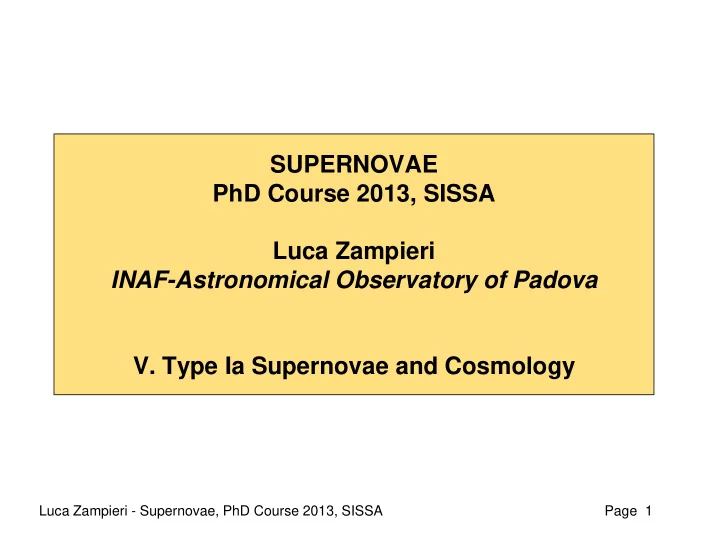

SUPERNOVAE PhD Course 2013, SISSA Luca Zampieri INAF-Astronomical Observatory of Padova V. Type Ia Supernovae and Cosmology Luca Zampieri - Supernovae, PhD Course 2013, SISSA Page 1
Type Ia SNe as distance indicators Luca Zampieri - Supernovae, PhD Course 2013, SISSA Page 2
Type Ia SNe: ‘standard candles’ It has long been recognized that Type Ia SNe could be very useful distance indicators (e.g. Branch & Tammann 1992; Branch 1998) because they have: exceedingly high luminosity: L=1.0e43 erg/s (B band magnitude=-19) • small dispersion among their peak absolute L (<0.3 mag) • homogeneous spectral properties, if compared at similar phases (Riess et al. 1997) • 80% of them are homogeneous (Branch et al. 1993) But also heterogeneity (Suntzeff 1996): SN 1991T • • no Si II or Ca II absorption lines in the pre-maximum spectrum • light curve broader and more luminous than average SN 1991bg • subluminous and intrinsically red • peculiar absorption (Ti II) • no secondary maximum in I band • Valenti et al. (2008) slow expanision velocity • Page 3
Calibrating Type Ia SNe Correlation between light curve shape and luminosity at maximum (Phillips 1993; Hamuy et al. 1995, 1996) • intrinsically bright SNe Ia decline more slowly than dim ones (correlation stronger in B band) • Dm15 measures the total drop from B-band maximum at t = 15 days after maximum (B magnitudes) • Phillips calibration relation (Phillips 1993): M max = -21.726+/-0.498 + (2.698+/-0.359) Dm15 Other parameterizations of the correlation: • ‘stretch’ factor, that multiplies the lightcurve timescale (Perlmutter et al. 1997; Goldhaber et al. 2001) • multi-color light curve shape (MLCS) method (Riess et al. 1996) http://wwwsupernova.lbl.gov/public/pa pers/aasposter198dir/wwwposter1d.jpg Luca Zampieri - Supernovae, PhD Course 2013, SISSA Page 4
Type Ia SNe: Cosmological use Luca Zampieri - Supernovae, PhD Course 2013, SISSA Page 5
Hubble diagram: low-z m max - M max = 5log D L – 5 D L = cz/H 0 z << 1 m max - M max = - 5 - 5log H 0 + 5 log cz After correcting M max with calibration relations, the correlation is significantly improved. Top: objects are assumed to be standard candles sigma = 0.42 mag, H0 = 58 ± 8 km/s/Mpc Bottom: same objects, after correcting M max sigma = 0.15 mag, H0 = 65 ± 2 km/s/Mpc Filippenko (2003) Luminosity distance Extending the Hubble diagram to higher redshifts, it is possible to probe additional cosmological parameters Page 6
Searches for Type Ia SNe at high-z Searching high-z Type Ia SNe • Pairs of first-epoch images (for removal of cosmic rays and asteroids) • Followed by second-epoch images 3 – 4 weeks later • Subtracting them, new SN candidates are identified • Spectra obtained as soon as possible after discovery to check type and determine z • Intensive photometric follow-up in filters that match the redshifted B and V bands • Correction for intrinsic cosmological strecth (1+z) ‘ Supernova Cosmology Project’ (SCP) led by Saul Perlmutter ’High -Z Supernova Search Time’ (HZT) led by Brian Schmidt and Adam Riess. Luca Zampieri - Supernovae, PhD Course 2013, SISSA Page 7
Hubble diagram: high-z First evidence of a low omega-m Universe and of omega-lambda>0 (Perlmutter et al. 1998; Filippenko and Riess 1998) Constraints from SNe and angular scale of the the CMB (Riess et al. 1998; Perlmutter et al. 1999) 1) omega-m + omega-lambda = 0.94 +/- 0.26 2) omega-lambda > 0 Filippenko (2003) Page 8 http://ned.ipac.caltech.edu/level5/March06/Overduin/ Figures/figure20.jpg
Putting all together Studies of clusters of galaxies (e.g. Bahcall et al. 1999) show that omega-m ≈ 0.3 Two-Degree Field Galaxy Redshift Survey (2dFGRS; Peacock et al. 2001; Percival et al. 2001; Efstathiou et al. 2002), combined with CMB maps, is inconsistent with a universe dominated by dark matter Wilkinson Microwave Anisotropy Prove (WMAP), together with the 2dFGRS constraints, confirmed and refined the concordance cosmology (Spergel et al. 2003): Omega-m = 0.27 http://hera.ph1.unikoeln.de/~heintzma/k 5/b3/Cosmic_Acc.gif Omega-lambda = 0.73 Omega-baryon = 0.044 H0 = 71 ± 4 km/s/Mpc t0 = 13.7 Gyrs For updated values from the 7 years WMAP observations see Larson et al. (2011) … and now results from the Planck mission!
Type Ia SNe: Systematic effects Luca Zampieri - Supernovae, PhD Course 2013, SISSA Page 10
Evolution, extinction by dust, systematic errors High- z SNe are dimmer than expected in an empty Universe. Possible systematics: • Evolution of peak luminosity of SNe Ia with z • Intergalactic grey dust extinction could dim SNe without causing significant reddening Current calibrations of Type Ia SNe include corrections for host galaxy properties and SN colors (spectral shape) Various tests performed with SNe segregated according to their light curve and host galaxy properties (e.g. Sullivan et al. 2012) errors of this type contribute at the 2% level Systematic uncertainties dominated by photometric (flux) calibration Page 11 Riess et al. (2004)
Dark Energy Equation of State Luca Zampieri - Supernovae, PhD Course 2013, SISSA Page 12
The most recent searches: Dark Energy EOS Supernova Legacy Survey three year sample (SNLS3): 472 SNe Ia Sample sufficiently large to constrain the dark energy parameters to a cosmologically interesting accuracy ( D L depends on w= α ) SNLS3 data + WMAP7 power spectrum + Sloan Digital Sky Survey luminous red galaxy angular power spectrum + Hubble constant from SHOES Results are consistent with a flat Universe, with w = p/rho c 2 = -1.069 + 0.091 -0.092 and no evolution (Sullivan et al. 2011) http://www.nature.com/ncomms/journal /v2/n6/images/ncomms1344-f2.jpg
Recommend
More recommend